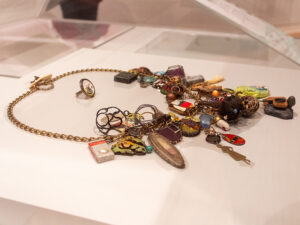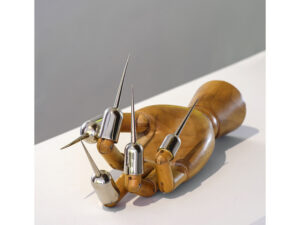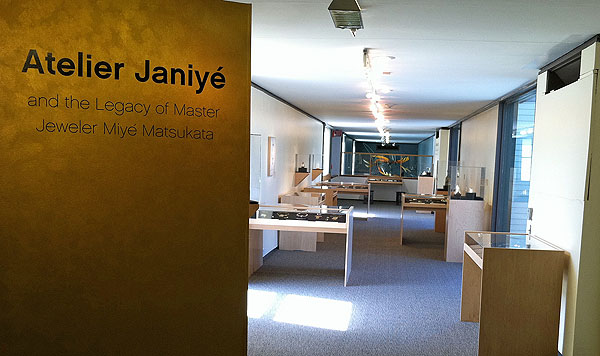
‘Miye Matsukata was among the first mid-century American studio jewelers to develop an expressionist feeling of spontaneity in one-of-a kind jewelry pieces. Known for combining precious and non-precious materials in open and abstract compositions, Matsukata embraced the incorporation of found objects and antique pieces, as well as alternative construction techniques in enamel and crocheted metals. Her careful combinations with high carat, multi-textured gold resulted in jewelry of extraordinary beauty, yet her legacy has been overlooked. Together with her accomplished colleagues this exhibition celebrates her innovation and spirit.’
While paying attention to the atelier’s founder, the exhibition is really the story of four jewelers, with Matsukata being joined by Alexandra Solowij Watkins, Nancy Michel and Yoshiko Yamamato, three colleagues who, becoming part of Atelier Janiye, have been critical to, as the wall text puts it, ‘developing a legacy of [Matsukata’s] spirit in one-of-a kind jewelry.’
The exhibition is located in a corridor gallery that begins after the gift shop and entrance and stops at the point where the stairs lead downstairs. It is a long, rectangular space filled with light-colored wooden cases and punctuated by floor-to-ceiling windows that look out onto the pond and fountain in the interior courtyard and then to the lake on the other side. The jewelry is lit by a row of lights that run down the centre of the gallery and the effect is, on a sunny day as when I visited, very pleasant.
While this is definitely a gallery setting, the introductory wall text seeks, right up front, to set another scene for the jewelry on display:
‘Jewelry demands the intimacy of touch and the participation of the wearer. Expressive as these pieces are, each is intended for wear and most of the works in this exhibition bear the signs of cherished ownership. Weddings, anniversaries, or the narrative of everyday life are bound to these pieces, all the more owing to their physical immediacy to our bodies. We are grateful to all the lenders to the exhibition who have graciously shared with us their personal stories and treasures.’
I am particularly interested in this statement, which reflects the fact that this jewelry has been integrated into peoples’ lives. There is no denying the artistic expression embodied in this jewelry and its studio jewelry credentials. Yet it is apparent how these objects leave space for their wearers: how it is contemporary jewelry, with the emphasis on the second word and not the first.

Within the cases, the logic appears to be loosely chronological. The earliest work by Matsukata comes from the 1950s and represents the first phase of her work as a jeweler. (The lack of explanatory wall text means that the viewer has to guess this.) A charm bracelet breaks the otherwise fairly standard primitivist and geometric abstract aesthetic of the earliest jewelry. And then things change. This is partly about materials – a shift to gold and semi-precious stones like jade, beach stones, citrine – and, in a 1960s brooch, the use of Egyptian charms, which are set within a silver frame. The aesthetic becomes more complex, with an evident emphasis on the handmade; with a delightful and intelligent awareness of materials and the contrast of different materials. It is as though Matsukata stops thinking about a predetermined aesthetic or style and starts to allow the jewelry to emerge from the particular materials and objects she works with. In a pair of jade earrings from the 1960s, the jade drops are fitted within a gold- articulated frame with hinges, and a kind of indeterminate pattern or texture acts like a reference to ornamental devices of historic jewelry. It is beautifully and wittily done. A necklace (1971) frames beach stones from Brimstone Island in Maine with irregular gold settings, interspersing them with irregular, freshwater pearls. Little patches of gold are applied to the surface of some of the stones, making a visual reference to the pearls and their lack of symmetry and perfection. Different karat gold creates additional effects.
In the second case, Matsukata’s jewelry changes towards even greater complexity, with these objects from the 1970s mostly tending towards assemblages of elements, accretions of parts. The effect is something like that of Hermann Jünger’s jewelry, a mixture of painterly effects created through materials and a kind of primitivism. Knitted or crocheted metal makes an appearance, as does thread.
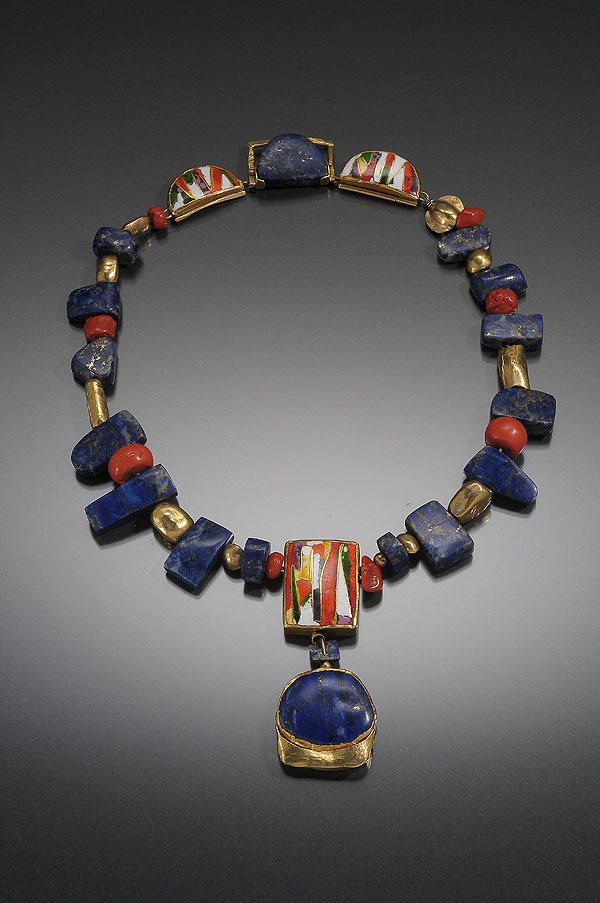
As a representation of Matsukata’s oeuvre, I can’t tell if it does justice to her practice because I don’t know enough about her work outside of this selection. It is, however, chronologically representative, beginning in the 1950s and concluding in the late 1970s, just before she died. And it does work to establish her as an excellent jeweler, making jewelry that is sophisticated and intelligent and well worth being included in the narrative of American studio jewelry. And yet the show doesn’t provide enough information to make sense of what the viewer sees. When did she graduate? How does the early work fit with the prevailing jewelry trends of the time? What stimulated the shift in the mid-1960s? How does it fit with other jewelry practices? The context, in other words, is missing. And nothing answers the question of the introductory text, which says that her legacy has been overlooked. Overlooked how? And why?
The cases featuring the jewelry of Alexandra Watkins have a dramatic span in terms of chronology: two very early pieces from the 1950s and a couple of works from the 1970s and 1980s, with most being made in the 1990s and 2000s. It is fascinating to compare Matsukata with Watkins. There are materials in common, a kind of fellow feeling and yet it is obvious you are not looking at the same maker. There is a structure to Watkins’s work, a geometrical solidity, an absence of the painterly fluidity of Matsukata’s approach. Found objects, such as pre-Columbian beads turned into a necklace remain themselves; stay beads, without being transformed into something else. It is as though Watkins is adding to a necklace, replacing missing parts, rather than creating a new object from found elements. I don’t mean to suggest the result is lesser, or worse, just to note the differences. Watkins frames materials; Matsukata incorporates them.

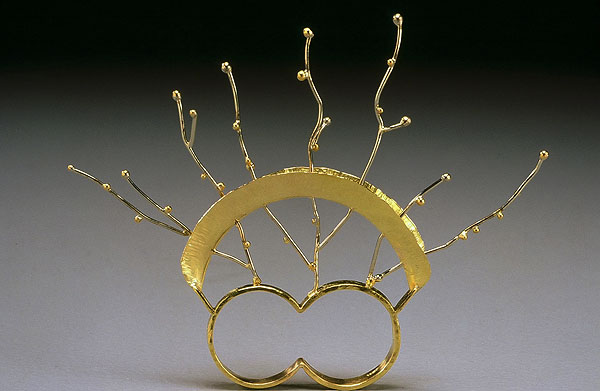
These problems are magnified when it comes to Yamamoto, whose two display cases almost can be split between work that you could imagine being sold at Atelier Janiye (from the late 1980s to early 2000s) and then jewelry that, through materials (styrofoam) and aesthetics, belongs within the realm of contemporary jewelry – by which I mean appealing to a small number of wearers and mostly to collectors and museums. Again, what are we seeing here? Is some of this work beyond Yamamoto’s role in the atelier, or has the atelier turned into a contemporary jewelry gallery?
The catalog for Atelier Janiye and the Legacy of Miye Matsukata is a fold-out brochure, full color, with an introductory essay by Perry Price, assistant curator at the Fuller Craft Museum, a checklist of the exhibition which takes up a whole inside (some works illustrated) and an essay from the director of the museum Wyona Lynch-McWhite. While Price’s essay is a nice introduction, it doesn’t go into detail, so the catalog is no help in drawing out the issues of the show that remain unclear.
It is ultimately frustrating that the exhibition refuses to examine the issue of the title – the legacy of Miye Matsukata. And yet I have to say that, while the frustration of the absence of curatorial framework is substantial, I like this show because of the work it puts on display – and the way you can see in microcosm the larger shifts of contemporary jewelry in the past half-century. The wearer is here, in spirit if not in person, as is the history of precious materials and creative expression, which within standard histories is mostly forgotten in contemporary jewelry’s embrace of the critique of preciousness. Even this turns up in the end, in Yamamoto’s jewelry. How much better it would be if this exhibition demonstrated more ambition – and thus did justice to the ambitions of the work on display.


